Last Saturday I shared a quick survey of religious colleges participating in the NCAA men’s basketball tournament. I mentioned upset winners Oral Roberts University only in passing, little suspecting that ORU would notch another victory on Sunday and make the Sweet Sixteen. So I’m thrilled to be able to share today’s guest post from Benjamin Young, on ORU’s founder and the role that basketball played in his educational ambitions.
After the 15th-seeded Golden Eagles of Oral Roberts University upset both Ohio State University and the University of Florida last weekend to advance to the Sweet Sixteen of the NCAA Division I Men’s Basketball Tournament, millions of Americans (their brackets now irrevocably busted) asked Google, “What is an Oral Roberts?” But fifty years ago, the upstart university founded by a Pentecostal faith-healing televangelist was the talk of American evangelicals. High-profile evangelical leaders, including Billy Graham, Carl F.H. Henry, and Bill Bright, allied themselves with Oral Roberts as he sought to build ORU into an evangelical research university that could compete in big-time college sports and train faith-minded doctors, lawyers, and PhD-credentialed scholars. Despite ORU’s initial, promising success in academics and athletics, its eventual decline revealed the limits of evangelical institution-building in late twentieth-century America.
When Oral Roberts founded ORU in Tulsa, Oklahoma in 1962, Pentecostals and other evangelicals had already blanketed the country with bible schools, liberal arts colleges, and seminaries. Roberts’s ambitions for ORU were loftier.
He had already proven himself a man of lofty dreams. In 1947, the Pentecostal preacher and his family had moved to Tulsa, Oklahoma with twenty-five dollars in hand to start a traveling faith-healing ministry. Within fifteen years he was one of the most recognizable (and controversial) Christian figures in the United States. Yet he recognized by the early 1960s that the revival tent was losing its appeal. “Why go to our tent,” he mused of his declining audiences, “when they could watch our television program in the comfort of their own living room each week?”[1] For Roberts (who lacked a bachelor’s degree himself), founding a university offered a new way of extending his healing ministry to coming generations. He envisioned ORU becoming what evangelicals had yet to achieve in the twentieth century, “a major, Class ‘A,’ academic university,” complete with professional schools in law, medicine, and business, as well as PhD programs to train up a new generation of Spirit-filled professors.[2] At the first meeting of the ORU Board of Regents in November 1962, Roberts put forward a strategic plan to realize this ambitious dream by 1980.
Oral Roberts’s most immediate challenge was earning the respect and support of Christians across the theological spectrum. Pentecostals’ more effusive spiritual practices — speaking in tongues, prophecy, and faith healing — had historically kept them far away from other streams of American evangelicalism. He recognized ORU’s success depended on his ability to break out of the Pentecostal mold and rally a big-tent constituency behind his university.
Advantageously for Roberts, his dreams for ORU happened to attract the attention of neo-evangelicals, a primarily northern network of moderate evangelicals who had organized in the 1940s and 1950s around institutions like the National Association of Evangelicals, Christianity Today, Wheaton College, and Fuller Seminary. Roberts had built his ministry empire independent of the neo-evangelicals, and their theological differences on the issues of faith healing and speaking in tongues had kept them coldly distant from each other through the 1950s. Roberts’s strategic plan for ORU, however, was strikingly similar to the long-held aims of neo-evangelical leaders to found their own research university. Carl F.H. Henry, neo-evangelicalism’s intellectual architect, broke the ice first by inviting Roberts to join Billy Graham and British evangelical icon John Stott at the Berlin World Conference on Evangelism in 1966.
It was in Berlin that Oral Roberts connected with neo-evangelical leaders for the first time and earned their support for ORU’s expansive strategic plan. Raymond Corvin, Roberts’s ministry associate, recorded the moment at the Berlin Conference where Roberts convinced them to back ORU:
One afternoon Oral attended an educational panel in which the general consensus was that Christian schools should carry the educational load through the bachelor’s degree in liberal arts and maybe up to the master’s degree, and do a good job, but because of the extensive outlay of capital they didn’t feel they had the financial strength to produce the program where the Ph.D. could be given. It was at that point that Brother Roberts stood up and said, “I believe Christianity should take the ball and move forward. We need at least 12 evangelical universities with their own doctoral programs. We can do it as we believe God!” And someone said, “It has been estimated that to build a school of this kind will cost 90 million dollars.” Brother Roberts said, “Well, that’s all right. We have already designed our program at ORU to be a Ph.D. granting institution, and it will cost 100 million. I cast my vote here today in favor of faith. By God’s help we in Christian education can build these great Christ-centered universities and furnish educators who really know the Lord.”[3]
Billy Graham and other neo-evangelicals were evidently quite taken with Roberts’s confidence in his project and his access to donors. In Berlin, Graham accepted Roberts’s invitation to be the keynote speaker at ORU’s dedication ceremonies in 1967. On a cloudy, windswept day that April, Graham delivered a rousing speech before an audience of students, parents, and ministry partners. “Evangelical Christendom can be proud today of this university,” Graham thundered, “and what it will mean to the future of this country.” With these words, Graham consecrated ORU as a neo-evangelical institution.
With Graham’s blessing, ORU grew rapidly through the late 1960s and early 1970s, in line with Roberts’s ambitious strategic plan. The university achieved provisional accreditation in 1967 and full accreditation in 1971. Its undergraduate student population grew by hundreds with each passing year. Unlike most Pentecostal colleges of the time, a majority of its student body came from non-Pentecostal backgrounds. If ORU’s student body did not fully agree on the use of spiritual gifts like prophecy and faith healing, they were largely united in their Republican politics. Straw polls reported that 77% of students voted for Richard Nixon in 1968; four years later, that figure grew to 81%.[4] A broadly-based Christian conservatism, rather than a narrow Pentecostal sectarianism, became the defining mark of ORU’s campus culture in its earliest years.

Roberts saw athletics, and men’s basketball in particular, as a key part of ORU’s Christian mission. “The world of sports,” he wrote in 1972, “is one of the greatest opportunities to witness [that] a Christian has.”[5] Thus, he invested heavily in athletics from ORU’s earliest years. Roberts hired Ken Trickey as men’s basketball coach in 1969 and two years later the duo orchestrated ORU’s early ascent to NCAA Division I status. Trickey put together a fast-paced offense that soon received notice from sportswriters across the country. Roberts fundraised and built exclusive student-athlete dormitories and, in 1972, constructed the Mabee Center, a 11,300-seat basketball arena.
Most importantly, Roberts used his celebrity as a recruiting tool. Coaches at other top programs cried foul when ORU secured the recruiting commitment of David Vaughn, a seven-foot center from Memphis, after Roberts preached at the church that Vaughn’s father pastored. Future hall of famer Moses Malone nearly committed to ORU after Roberts personally visited Malone’s home in Virginia and prayed with his mother.[6]
ORU’s most prolific recruit, however, was Richard Fuqua, a speedy shooting guard who averaged 35.9 points per game in his junior season in 1971-72 and earned second team All-American honors. Fuqua and ORU’s plucky basketball program captivated the nation. Sport magazine profiling the team in an article entitled “Praise the Lord and Pass the Ball to Fuqua.” ORU made its deepest postseason run yet in 1974, a year after Fuqua’s graduation, reaching the Elite Eight of the NCAA Division 1 Men’s Basketball Tournament.
ORU’s Cinderella run to the Elite Eight in 1974 reinforced the speedy progress that the school had made towards research university status. The university’s $150-million campus, constructed in an eye-catching, futuristic style, was taking shape. ORU’s showy, space-age built environment was an impressive backdrop for Roberts’s quarterly primetime specials on NBC, which were drawing staggering television audiences in the tens of millions. In this favorable climate, Roberts took the crucial next step towards transforming ORU into a research university in April 1975: he announced that ORU would charter graduate schools in medicine, law, dentistry, business, and theology by 1980.
After 1974, ORU’s basketball fortunes faded and, in the years to follow, so would Roberts’s vision for an evangelical research university. Ken Trickey left ORU in 1974 over tensions with Roberts. The men’s basketball program subsequently endured a ten-year March Madness drought. Meanwhile, Roberts faced immense financial and accreditation challenges in the late 1970s as he struggled to establish ORU’s graduate schools. ORU’s law school opened in 1979 but toiled for years to gain full accreditation from the American Bar Association, which balked at ORU’s requirement that faculty and students sign a statement of faith. Inspired by what he described as a prophetic vision, Roberts’s proposed medical school ballooned into the City of Faith Medical and Research Center, a massive, $150-million medical park housed in a three-skyscraper complex.

At first, City of Faith received an enthusiastic reception from high-profile evangelical leaders. Billy Graham appeared on Roberts’s television program to encourage viewers to donate to the medical park’s construction. Campus Crusade for Christ founder Bill Bright made plans with Roberts to establish a program through which ORU medical students could serve as short-term medical missionaries. The construction of City of Faith, however, nearly bankrupted Roberts’s ministry. ORU plunged into even more dire financial straits after the complex’s improbable completion in 1981, when the hundreds of thousands of patients that Roberts had projected would flock to City of Faith did not materialize. In 1985, to cut costs, ORU shuttered its short-lived dental school and sold its law school to fellow televangelist Pat Robertson’s CBN University (later Regent University). Two years later, Roberts’s public approval plummeted when he prophesied that God would “take him home” if supporters failed to raise $8 million for a medical school scholarship program. Amid the growing weight of negative press, figures like Graham and Bright distanced themselves from Roberts.
ORU’s athletic department was not immune from City of Faith’s disastrous financial effect on Roberts’s ministries. In 1989, ORU withdrew from the NCAA and joined the NAIA, a cheaper, lower-tier intercollegiate athletics association. That same year, the ORU Board of Regents permanently closed City of Faith and disbanded the medical school, citing the combined $25-million debt that both ventures had accumulated. With these closures, Roberts’s thirty-year project of creating an evangelical research university came to an unceremonious end.
ORU would survive into the 1990s as a modest, teaching-focused undergraduate institution under the presidency of Oral’s son, Richard Roberts. In the three decades since the fall of City of Faith, evangelical colleges and universities like ORU have continued to make up a key part of the landscape of American higher education. But the dream of a firmly evangelical research university with graduate programs, professional schools, and big-time college sports — a dream long shared by Oral Roberts, Carl F.H. Henry, Billy Graham, and others — would remain elusive.
When Richard Robert’s tenure as ORU’s president ended in 2007 under a cloud of allegations of financial mismanagement and misconduct, ORU was reborn through a $70-million gift from the Green Family (owners of Hobby Lobby), who implemented several management reforms. Men’s basketball was as instrumental in ORU’s rebirth in the late 2000s as it was during the university’s initial rise in the 1970s. The Golden Eagles, having returned to NCAA Division I status after their sojourn in the NAIA, qualified for March Madness for three straight seasons, from 2006 through 2008. In 2021, under head coach Paul Mills, ORU has returned to March Madness, and the national spotlight, once more.
As a faith healer, Oral Roberts operated in the realm of the miraculous. When ORU takes on heavily favored Arkansas tonight with a trip to the Elite Eight at stake, perhaps March Madness will produce another miracle.
Benjamin Young is a senior at Baylor University in Waco, Texas, where he majors in History and Religion. His research engages the intersections of religion, politics, culture, and metropolitan development in the twentieth-century United States. He will begin work on a PhD in History at the University of Notre Dame in the fall of 2021.
[1] Oral Roberts, The Call: An Autobiography (Garden City, NY: Doubleday & Company, 1972), 175.
[2] David Harrell Jr., Oral Roberts: An American Life (Bloomington, IN: Indiana University Press, 1985), 210-11.
[3] R.O. Corvin, “Oral Roberts and R.O. Corvin Attend World Congress on Evangelism in Berlin,” Abundant Life 21, no. 1 (January 1967): 21-22.
[4] “‘Nixon’s the One’ at ORU,” Oracle (Tulsa, OK, October 25, 1968): 1; “Oracle Political Poll Shows Nixon Leading,” Oracle (Tulsa, OK, October 27, 1972).
[5] Roberts, The Call, 215.
[6] Harrell Jr., Oral Roberts, 244-48.












